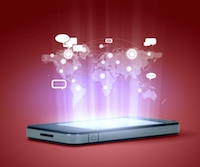Why Small Screen Mobile Has Become Really Big in Healthcare Marketing

The proliferation of ever-present and always-on mobile devices is reshaping hospital and medical practice marketing plans, making the “small screen” an unprecedented “big thing” for medical marketers. Many of the sharpest healthcare folks that I know are getting ahead of the crowd and linking their marketing strategies and tactics to the explosion of mobile devices.
If you have not already adjusted to the innovation upheaval, consider…
- PROLIFERATION: Mobile devices, cell phones, smartphones, tablet are mainstream in American society; over 60 percent of the population use smartphones.
- IMMEDIACY: The majority of Americans (including your prospects) enjoy anytime/anywhere access to information, often at the real-time moment they need or want information.
- CAPABILITIES: Mobile devices are smaller, faster and smarter…capable of geospatial tracking, remote monitoring, tracking and analytics and other uses, far beyond “making a phone call.”
Further, mobile devices—particularly smartphones—are capable of precision audience targeting for marketing, online advertising, email, specific purpose apps and other direct-to-consumer (and sometimes two-way) messaging. [Pew Research] [Deloitte]
Because smartphones and mobile devices are so prolific, they are reshaping the ways that marketers and consumers interact. Customers often expect a mobile-friendly website, and are willing and able to leave (with a quick click) for a competitor’s information.
Some of the compelling numbers…
235 million – Americans using mobile devices, according to Comscore data
165 million – Active Android and Apple iOS devices in the US
78 percent – adult population (age 15-64) using smartphones
21 percent – patients booking appointments via online or mobile
77 percent – patients using online search prior to booking a medical appointment
83 percent – patients booking appointment after searching hospital sites
44 percent – more patients schedule an appointment after using a mobile device to watch a related video over computer only searches
[Google Think research and BusinessInsider]
As further evidence, the Apple iPhone folks, who already dominate the smartphone market at 41 percent, are gearing up for yet another new device release. Apple is traditionally silent, but Forbes and the Wall Street Journal say that suppliers are building 50 to 60 million of the latest-and-greatest iPhone 6 for Fall release. (About 500 million iPhones have already been sold worldwide.)
Increasingly, patients expect to be able to communicate with their doctor’s office via email. And looking ahead, recent data has yet to reflect emerging trends in various wearable technology applications and related health care and marketing implications.
The importance of designing and delivering your healthcare marketing message—in ways that include the explosive mobile revolution—is an opportunity to effectively and immediately reach more people in your service area at a time when they need and want medical information.
For additional, how-to reading about creating a successful mobile strategy, see these articles: The Mobile Tipping Point: Optimize Your Healthcare Site or Vanish, and 4.2 Billion Toothbrushes and your Mobile Marketing Strategy is Missing.
Lori Waltz
Related Articles:
Get Small: The Digital World is a Mobile World
10 More Compelling Reasons Healthcare Marketing Absolutely Must “Think Mobile”
Retooling Healthcare Marketing for the Small Screen
A Deep Dive into Tomorrow’s Mobile Marketing
The Mobile Tipping Point: Optimize Your Healthcare Site or Vanish









